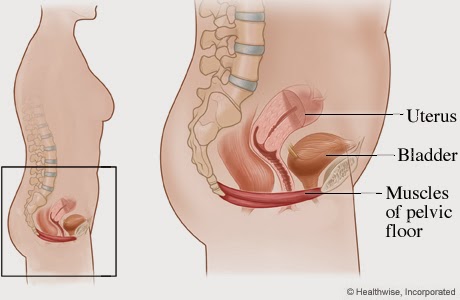Pelvic Floor Exercise
First published in 1948 by Dr. Arnold Kegel, a pelvic floor exercise, more commonly called a Kegel exercise, consists of repeatedly contracting and relaxing the muscles that form part of the pelvic floor.
 |
| Pelvic floor muscles |
The aim of Kegel exercises is to improve muscle tone by
strengthening the pubococcygeus muscles of the pelvic floor. Kegel is a
popular prescribed exercise for pregnant women
to prepare the pelvic floor for
physiological stresses of the later stages of pregnancy and childbirth. Kegel exercises are
said to be good for treating vaginal prolapse and preventing uterine prolapse in women and for treating prostate pain
and swelling resulting from benign prostatic hyperplasia (BPH) and prostatitis in
men. Kegel exercises may be beneficial in treating urinary incontinence in both men and women. Kegel exercises may also increase sexual
gratification and aid in reducing premature ejaculation. The many actions performed by Kegel
muscles include holding in urine and avoiding defecation. Reproducing this type
of muscle action can strengthen the Kegel muscles. The action of slowing or
stopping the flow of urine may be used as a test of correct pelvic floor
exercise technique but should not be practiced as a
regular exercise to avoid urinary retention.
A pelvic toning device (generically referred to as a Kegel exerciser, pelvic floor toner, pelvic
floor muscle toner or pelvic toner) is a medical or pseudo-medical device
designed to help women exercise their pelvic floor muscle and improve the muscle
tone of the pubococcygeal or vaginal muscle, barbells, vaginal weights or cones
designed to be held in the vagina. The action of passively/actively retaining
the device internally is supposed to improve muscle tone. Barbells are made of
smooth, polished solid stainless steel, cylindrical in
shape, with a rounded bulge at each end. They typically weigh one pound (454 g)
and measure approximately 63⁄4 inches
(17 cm) in length with a diameter of one inch (2.5 cm) at the widest
part.
 |
| A Kegel exerciser |
 |
| Pelvic floor toner exercise |
Find the right
muscles
Insert a finger inside your vagina and try to squeeze
the surrounding muscles. You should feel your vagina tighten and your pelvic
floor move upward. Then relax your muscles and feel your pelvic floor return to
the starting position. You can also try to stop the flow of urine when you
urinate. If you succeed, you've got the basic move. Don't make a habit of
starting and stopping your urine stream, though. Doing Kegel exercises with a
full bladder or while emptying your bladder can actually weaken the muscles, as
well as lead to incomplete emptying of the bladder — which increases the risk
of a urinary tract infection.
1. Begin by emptying your bladder.
2. Tighten the pelvic floor muscles and hold for a count
of 10.
3. Relax the muscles completely for a count of 10.
4. Do 10 repititions, 3 to 5 times a day (morning,
afternoon, and night).
You can do these exercises at any time and any place.
Most people prefer to do the exercises while lying down or sitting in a chair.
After 4 - 6 weeks, most people notice some improvement. It may take as long as
3 months to see a major change.
Breathe normally during the exercises, and do this at
least three times a day. Try not to move your leg, buttock, or abdominal
muscles during the exercises.


.jpg)
Comments
Post a Comment